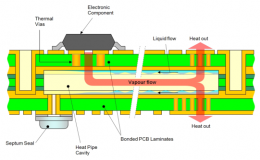Steampipe keeps electronics cool

(PhysOrg.com) -- The cooling of electronic components is playing an increasing role in the design process of electronic equipment such as mobile telephones, games computers and laptops. Wessel Wits, PhD student at the University of Twente, has developed two innovative concepts for cooling such devices. Patents for both concepts are pending. Wits will be awarded his doctorate on 4 December at the faculty of Engineering Technology.
Electronic components on the printed circuit boards used in electrical devices are becoming smaller and smaller, whilst their performances (must) improve. This means that more heat is released on a continually shrinking surface area.

Industry is currently facing two problems in the cooling of electronics: the components on a printed circuit board are so close to one another that there is hardly any room left to cool them individually and the components themselves release so much concentrated heat that the cooling capacity is not strong enough to cool them. Wits looked for solutions to these two problems. In cooperation with Thales Nederland, a company that specializes in developing radar systems, he has developed two new concepts. The first concept cools using air, the second is a closed evaporation system.
Air cooling
The first concept – directly injected cooling – is based on air cooling. Small openings are made on the bottom of the printed circuit board under the electronic components. These ‘inflow openings’ cool the components directly from below. The big advantage of this concept is that it can cool various components independently of one another or simultaneously.
Closed evaporation system
The second concept – integrated heat pipe cooling – is based on the evaporation of liquid in a closed system. This liquid is located in the so-called ‘heat pipe’, a principle that is well-known but that had never been fully integrated in a printed circuit board until now. The liquid evaporates from a capillary structure at the spot where the heat is released. The evaporation withdraws heat locally from the environment. The vapour subsequently flows through the ‘heat pipe’ and condenses at some distance from the electrical component to be cooled. The latent heat is once again converted to perceptible heat at this site. This concept stands out because it is able to transport heat highly efficiently, without a pump or other external energy source.
Compared with current cooling systems, both concepts show promising results in terms of good thermal performance and great flexibility. They also lead to a lighter, compacter electronic product. No new production techniques will have to be developed in order to incorporate these concepts in current printed circuit boards. As a result, time can be gained during production and considerable cost savings will be possible.
Provided by University of Twente





















